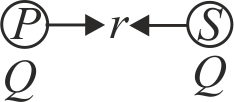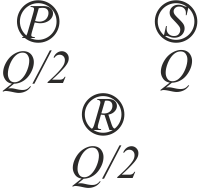358075 A point charge \({A}\) of \({+10 \mu C}\) and another point charge \({B}\) of \( + 20\,\mu C\) are kept \({1 m}\) apart in free space. The electrostatic force on \({A}\) due to \({B}\) is \({\vec{F}_{1}}\) and the electrostatic force on \({B}\) due to \({A}\) is \({\vec{F}_{2}}\). Then
358076 Two identical conducting spheres \(P\) and \(S\) with charge \(Q\) on each, repel each other with a force \(16\,N\) A third identical uncharged conducting sphere \(R\) is successively brought in contact with the two spheres. The new force of repulsion between \(P\) and \(S\) is
358075 A point charge \({A}\) of \({+10 \mu C}\) and another point charge \({B}\) of \( + 20\,\mu C\) are kept \({1 m}\) apart in free space. The electrostatic force on \({A}\) due to \({B}\) is \({\vec{F}_{1}}\) and the electrostatic force on \({B}\) due to \({A}\) is \({\vec{F}_{2}}\). Then
358076 Two identical conducting spheres \(P\) and \(S\) with charge \(Q\) on each, repel each other with a force \(16\,N\) A third identical uncharged conducting sphere \(R\) is successively brought in contact with the two spheres. The new force of repulsion between \(P\) and \(S\) is
358075 A point charge \({A}\) of \({+10 \mu C}\) and another point charge \({B}\) of \( + 20\,\mu C\) are kept \({1 m}\) apart in free space. The electrostatic force on \({A}\) due to \({B}\) is \({\vec{F}_{1}}\) and the electrostatic force on \({B}\) due to \({A}\) is \({\vec{F}_{2}}\). Then
358076 Two identical conducting spheres \(P\) and \(S\) with charge \(Q\) on each, repel each other with a force \(16\,N\) A third identical uncharged conducting sphere \(R\) is successively brought in contact with the two spheres. The new force of repulsion between \(P\) and \(S\) is
358075 A point charge \({A}\) of \({+10 \mu C}\) and another point charge \({B}\) of \( + 20\,\mu C\) are kept \({1 m}\) apart in free space. The electrostatic force on \({A}\) due to \({B}\) is \({\vec{F}_{1}}\) and the electrostatic force on \({B}\) due to \({A}\) is \({\vec{F}_{2}}\). Then
358076 Two identical conducting spheres \(P\) and \(S\) with charge \(Q\) on each, repel each other with a force \(16\,N\) A third identical uncharged conducting sphere \(R\) is successively brought in contact with the two spheres. The new force of repulsion between \(P\) and \(S\) is


